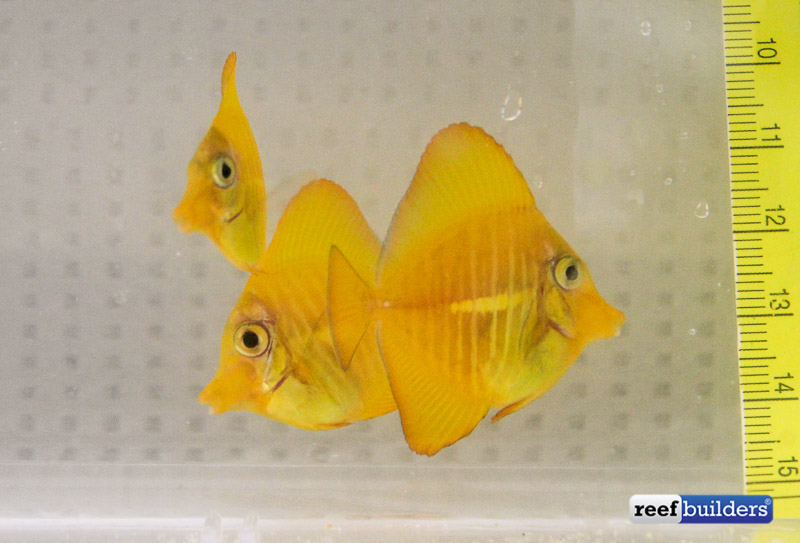The Oceanic Institute together with the Rising Tide Conservation project have finally broken through with successfully breeding and raising the yellow tang in captivity. So you may be wondering, when will you be able to pick up captive bred yellow tangs at the LFS? Not so fast.
The work that has been done to breed yellow tangs in captivity by the Oceanic Institute is merely a long term research project, and it was intended primarily to develop the methods for rearing ‘finfish’ in general, with Zebrasoma flavescens being just one of the species that they work with.

At this time the Oceanic Institute has moved about 187 baby yellow tangs into a large tank for grow-out, and they have a new crop of about 500 pelagic larval yellow tangs about to metamorphose into tiny juveniles. You can see that from the updated pictures of the juvenile yellow tangs that the baby fish are not about 3cm or one inch tall, with a beautiful yellow color that is broken only by very few vertical stripes, typical of juvenile Zebrasoma.
Although they are tiny and captive bred, there is still a little bit of aggression. First generations of captive bred clownfish and dottybacks often showed lots of deformed bodies, fins and mouth parts but thankfully we’ve been informed that there are very few deformities visible in the first captive bred yellow tang.

You can see a little bit of strong golden orange coloration in the margins of the dorsal and anal fins of these yellow tangs, and we have to wonder if this is perhaps an artifact of feeding the fish a diet high in carotenoids. We’ve seen this orange halo develop in yellow tangs which are overfed with red algaes and cyclopeeze but this could also be an artifact of captive growing conditions with fin-nipping from fellow yellow tang tankmates.
Despite these large numbers of fish, the primary work at the Oceanic Institute is for research, and there are no plans to turn into a yellow tang factory to satisfy the aquarium demand for this fish. The work of the Oceanic Institue is funded with various grants and donations, with Rising Tide contributing only a small part of the capital necessary to keep the project running.
We don’t expect any more hurdles to arise in the rearing of these first captive bred yellow tangs so what will become of this first hundred aquarium grown Z. flavescens? The intention is to distribute some of these fish to public aquariums where the fish can be put on exhibit, explaining the significance of these captive bred fish.

Perhaps some of the fish will be released in limited quantity to the aquarium market, but these will be in an extremely small numbers. Many of the fish will be kept for maturing to adulthood and establishing the next generation of captive bred yellow tangs. Thankfully, the real success of the Oceanic Institute was in developing the methods for raising these fish in captivity.
A future article or paper will detail the methods that resulted in these successfully captive bred fish so that any determined fish farmer will be able to duplicate their efforts. We tend to think that raising the larvae with proper pelagic foods is usually the hardest part of breakthroughs with breeding any new species of marine fish.
But in the yellow tang’s case, it just took a long time to get good quality eggs from the adults, eggs which developed into larvae hardy and healthy enough to survive the two month pelagic stage until they could settle out into tiny little reef fish. If you want to help out the Oceanic Institute’s efforts to breed yellow tangs in captivity, you can contribute directly to their efforts in a their crowdfunding campaign on GoFundMe.



